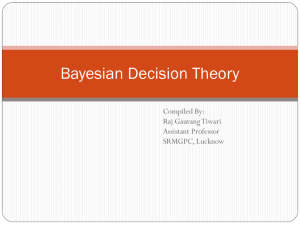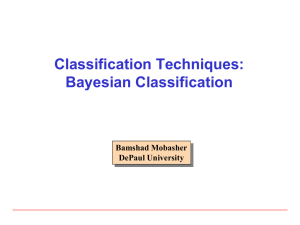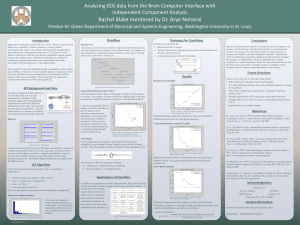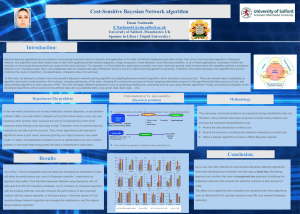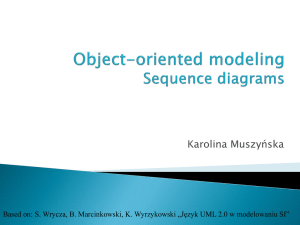Bayesian Classification, Nearest Neighbors, Ensemble Methods
advertisement
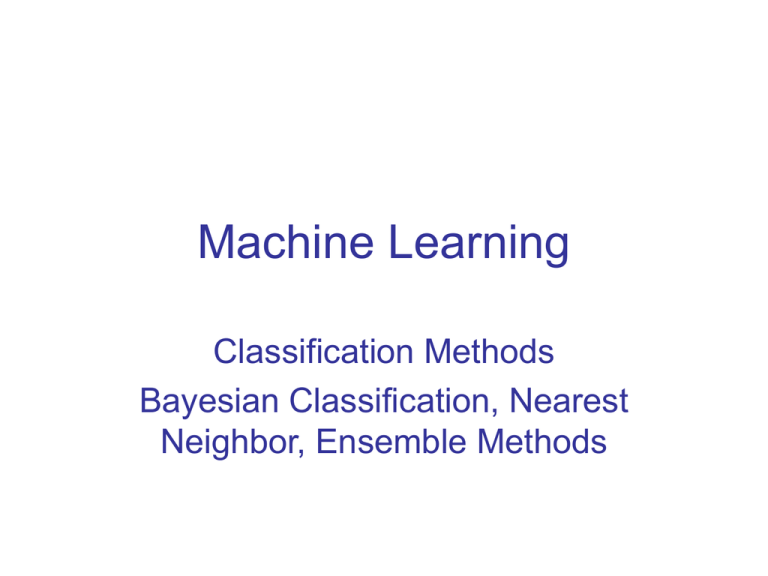
Machine Learning
Classification Methods
Bayesian Classification, Nearest
Neighbor, Ensemble Methods
Bayesian Classification: Why?
A statistical classifier: performs probabilistic prediction,
i.e., predicts class membership probabilities
Foundation: Based on Bayes’ Theorem.
Performance: A simple Bayesian classifier, naïve Bayesian
classifier, has comparable performance with decision tree
and selected neural network classifiers
Incremental: Each training example can incrementally
increase/decrease the probability that a hypothesis is
correct — prior knowledge can be combined with
observed data
April 9, 2015
Data Mining: Concepts and Techniques
2
Bayes’ Rule
P ( d | h) P ( h)
p(h | d )
P(d )
Underst anding Bayes' rule
d dat a
h hypot hesis(model)
- rearranging
p(h | d ) P(d ) P(d | h) P(h)
P(d , h ) P(d , h)
Who is who in Bayes’ rule
P( h ) :
P( d | h ) :
t hesame joint probability
on bot h sides
prior belief (probability of hypothesish beforeseeing any data)
likelihood (probability of the data if the hypothesish is true)
P(d ) P(d | h) P(h) : data evidence(marginal probability of the data)
h
P( h | d ) :
posterior (probability of hypothesish after having seen the data d )
Example of Bayes Theorem
Given:
A doctor knows that meningitis causes stiff neck 50% of the time
Prior probability of any patient having meningitis is 1/50,000
Prior probability of any patient having stiff neck is 1/20
If a patient has stiff neck, what’s the probability
he/she has meningitis?
P( S | M ) P( M ) 0.5 1 / 50000
P( M | S )
0.0002
P( S )
1 / 20
Choosing Hypotheses
Maximum Likelihood
hypothesis:
hML arg max P(d | h)
Generally we want the most
probable hypothesis given
training data.This is the
maximum a posteriori
hypothesis:
hMAP arg max P(h | d )
Useful observation: it does
not depend on the
denominator P(d)
hH
hH
Bayesian Classifiers
Consider each attribute and class label as random
variables
Given a record with attributes (A1, A2,…,An)
Goal is to predict class C
Specifically, we want to find the value of C that maximizes
P(C| A1, A2,…,An )
Can we estimate P(C| A1, A2,…,An ) directly from
data?
Bayesian Classifiers
Approach:
compute the posterior probability P(C | A1, A2, …, An) for all values
of C using the Bayes theorem
P(C | A A A )
1
2
n
P( A A A | C ) P(C )
P( A A A )
1
2
n
1
2
Choose value of C that maximizes
P(C | A1, A2, …, An)
Equivalent to choosing value of C that maximizes
P(A1, A2, …, An|C) P(C)
How to estimate P(A1, A2, …, An | C )?
n
Naïve Bayes Classifier
Assume independence among attributes Ai when class is
given:
P(A1, A2, …, An |C) = P(A1| Cj) P(A2| Cj)… P(An| Cj)
Can estimate P(Ai| Cj) for all Ai and Cj.
This is a simplifying assumption which may be violated in
reality
The Bayesian classifier that uses the Naïve Bayes assumption
and computes the MAP hypothesis is called Naïve Bayes
classifier
cNaive Bayes arg max P(c) P(x | c) arg max P(c) P(ai | c)
c
c
i
How to Estimate
Probabilities
l
l
s
a
a
u
c
c
o
ri
ri
u
o
o
from Data?
in
g
g
ss
te
te
nt
Tid
10
ca
ca
co
a
cl
Refund
Marital
Status
Taxable
Income
Evade
1
Yes
Single
125K
No
2
No
Married
100K
No
3
No
Single
70K
No
4
Yes
Married
120K
No
5
No
Divorced
95K
Yes
6
No
Married
60K
No
7
Yes
Divorced
220K
No
8
No
Single
85K
Yes
9
No
Married
75K
No
10
No
Single
90K
Yes
Class: P(C) = Nc/N
e.g., P(No) = 7/10,
P(Yes) = 3/10
For discrete attributes:
P(Ai | Ck) = |Aik|/ Nc
k
where |Aik| is number of
instances having attribute Ai and
belongs to class Ck
Examples:
P(Status=Married|No) = 4/7
P(Refund=Yes|Yes)=0
How to Estimate Probabilities
from Data?
For continuous attributes:
Discretize the range into bins
Two-way split: (A < v) or (A > v)
one ordinal attribute per bin
violates independence assumption
choose only one of the two splits as new attribute
Probability density estimation:
Assume attribute follows a normal distribution
Use data to estimate parameters of distribution
(e.g., mean and standard deviation)
Once probability distribution is known, can use it to
estimate the conditional probability P(Ai|c)
l
al
How to riEstimate
u sProbabilities from
ca
c
i
o
r
o
o
nu
i
g
g
t
ss
e
e
t
t
n
a
Data?
cl
ca
ca
co
Tid
Refund
Marital
Status
Taxable
Income
Evade
1
Yes
Single
125K
No
2
No
Married
100K
No
3
No
Single
70K
No
4
Yes
Married
120K
No
5
No
Divorced
95K
Yes
6
No
Married
60K
No
7
Yes
Divorced
220K
No
8
No
Single
85K
Yes
9
No
Married
75K
No
10
No
Single
90K
Yes
Normal distribution:
1
P( A | c )
e
2
i
j
( Ai ij ) 2
2 ij2
2
ij
One for each (Ai,ci) pair
For (Income, Class=No):
If Class=No
sample mean = 110
sample variance = 2975
10
1
P( Income 120 | No)
e
2 (54.54)
( 120110) 2
2 ( 2975)
0.0072
Naïve Bayesian Classifier:
Training Dataset
Class:
C1:buys_computer = ‘yes’
C2:buys_computer = ‘no’
New Data:
X = (age <=30,
Income = medium,
Student = yes
Credit_rating = Fair)
April 9, 2015
age
<=30
<=30
31…40
>40
>40
>40
31…40
<=30
<=30
>40
<=30
31…40
31…40
>40
income studentcredit_rating
buys_compu
high
no fair
no
high
no excellent
no
high
no fair
yes
medium
no fair
yes
low
yes fair
yes
low
yes excellent
no
low
yes excellent
yes
medium
no fair
no
low
yes fair
yes
medium yes fair
yes
medium yes excellent
yes
medium
no excellent
yes
high
yes fair
yes
medium
no excellent
no
Data Mining: Concepts and Techniques
12
Naïve Bayesian Classifier:
An Example
Given X (age=youth, income=medium, student=yes, credit=fair)
Maximize P(X|Ci)P(Ci), for i=1,2
First step: Compute P(C) The prior probability of each class can be
computed based on the training tuples:
P(buys_computer=yes)=9/14=0.643
P(buys_computer=no)=5/14=0.357
Naïve Bayesian Classifier:
An Example
Given X (age=youth, income=medium, student=yes, credit=fair)
Maximize P(X|Ci)P(Ci), for i=1,2
Second step: compute P(X|Ci)
P(X|buys_computer=yes)= P(age=youth|buys_computer=yes)x
P(income=medium|buys_computer=yes) x
P(student=yes|buys_computer=yes)x
P(credit_rating=fair|buys_computer=yes)
= 0.044
P(age=youth|buys_computer=yes)=0.222
P(income=medium|buys_computer=yes)=0.444
P(student=yes|buys_computer=yes)=6/9=0.667
P(credit_rating=fair|buys_computer=yes)=6/9=0.667
Naïve Bayesian Classifier:
An Example
Given X (age=youth, income=medium, student=yes, credit=fair)
Maximize P(X|Ci)P(Ci), for i=1,2
Second step: compute P(X|Ci)
P(X|buys_computer=no)= P(age=youth|buys_computer=no)x
P(income=medium|buys_computer=no) x
P(student=yes|buys_computer=no) x
P(credit_rating=fair|buys_computer=no)
= 0.019
P(age=youth|buys_computer=no)=3/5=0.666
P(income=medium|buys_computer=no)=2/5=0.400
P(student=yes|buys_computer=no)=1/5=0.200
P(credit_rating=fair|buys_computer=no)=2/5=0.400
Naïve Bayesian Classifier:
An Example
Given X (age=youth, income=medium, student=yes, credit=fair)
Maximize P(X|Ci)P(Ci), for i=1,2
We have computed in the first and second steps:
P(buys_computer=yes)=9/14=0.643
P(buys_computer=no)=5/14=0.357
P(X|buys_computer=yes)= 0.044
P(X|buys_computer=no)= 0.019
Third step: compute P(X|Ci)P(Ci) for each class
P(X|buys_computer=yes)P(buys_computer=yes)=0.044 x 0.643=0.028
P(X|buys_computer=no)P(buys_computer=no)=0.019 x 0.357=0.007
The naïve Bayesian Classifier predicts X belongs to class (“buys_computer =
yes”)
Example
c
Tid
Training set :
(Öğrenme Kümesi)
at
Refund
o
g
e
l
a
ric
c
at
o
g
e
l
a
ric
co
in
t
n
u
s
u
o
as
l
c
Marital
Status
Taxable
Income
Evade
1
Yes
Single
125K
No
2
No
Married
100K
No
3
No
Single
70K
No
4
Yes
Married
120K
No
5
No
Divorced
95K
Yes
6
No
Married
60K
No
7
Yes
Divorced
220K
No
8
No
Single
85K
Yes
9
No
Married
75K
No
10
No
Single
90K
Yes
s
10
Given a Test Record:
X (Refund No, Married, Income 120K)
k
Example of Naïve Bayes Classifier
Given a Test Record:
X (Refund No, Married, Income 120K)
naive Bayes Classifier:
P(Refund=Yes|No) = 3/7
P(Refund=No|No) = 4/7
P(Refund=Yes|Yes) = 0
P(Refund=No|Yes) = 1
P(Marital Status=Single|No) = 2/7
P(Marital Status=Divorced|No)=1/7
P(Marital Status=Married|No) = 4/7
P(Marital Status=Single|Yes) = 2/7
P(Marital Status=Divorced|Yes)=1/7
P(Marital Status=Married|Yes) = 0
For taxable income:
If class=No:
sample mean=110
sample variance=2975
If class=Yes: sample mean=90
sample variance=25
P(X|Class=No) = P(Refund=No|Class=No)
P(Married| Class=No)
P(Income=120K| Class=No)
= 4/7 4/7 0.0072 = 0.0024
P(X|Class=Yes) = P(Refund=No| Class=Yes)
P(Married| Class=Yes)
P(Income=120K| Class=Yes)
= 1 0 1.2 10-9 = 0
Since P(X|No)P(No) > P(X|Yes)P(Yes)
Therefore P(No|X) > P(Yes|X)
=> Class = No
Avoiding the 0-Probability Problem
If one of the conditional probability is zero, then the
entire expression becomes zero
Probability estimation:
N ic
Original: P( Ai | C )
Nc
N ic 1
Laplace: P( Ai | C )
Nc c
N ic m p
m - estimate: P( Ai | C )
Nc m
c: number of classes
p: prior probability
m: parameter
Naïve Bayes (Summary)
Advantage
Robust to isolated noise points
Handle missing values by ignoring the instance during probability
estimate calculations
Robust to irrelevant attributes
Disadvantage
Assumption: class conditional independence, which may cause loss
of accuracy
Independence assumption may not hold for some attribute.
Practically, dependencies exist among variables
Use other techniques such as Bayesian Belief Networks (BBN)
Remember
Bayes’ rule can be turned into a classifier
Maximum A Posteriori (MAP) hypothesis estimation
incorporates prior knowledge; Max Likelihood (ML) doesn’t
Naive Bayes Classifier is a simple but effective Bayesian
classifier for vector data (i.e. data with several attributes)
that assumes that attributes are independent given the
class.
Bayesian classification is a generative approach to
classification
Classification Paradigms
In fact, we can categorize three fundamental approaches
to classification:
Generative models: Model p(x|Ck) and P(Ck) separately
and use the Bayes theorem to find the posterior
probabilities P(Ck|x)
Discriminative models:
E.g. Naive Bayes, Gaussian Mixture Models, Hidden Markov
Models,…
Determine P(Ck|x) directly and use in decision
E.g. Linear discriminant analysis, SVMs, NNs,…
Find a discriminant function f that maps x onto a class
label directly without calculating probabilities
Slide from B.Yanik
Bayesian Belief Networks
Bayesian belief network allows a subset of the variables to
be conditionally independent
A graphical model of causal relationships (neden sonuç
ilişkilerini simgeleyen bir çizge tabanlı model)
Represents dependency among the variables
Gives a specification of joint probability distribution
Nodes: random variables
X
Links: dependency
Y
X and Y are the parents of Z, and Y is
Z
P
the parent of P
No dependency between Z and P
Has no loops or cycles
April 9, 2015
Data Mining: Concepts and Techniques
23
Bayesian Belief Network: An Example
Family
History
Smoker
The conditional probability table
(CPT) for variable LungCancer:
(FH, S) (FH, ~S) (~FH, S) (~FH, ~S)
LungCancer
Emphysema
LC
0.8
0.5
0.7
0.1
~LC
0.2
0.5
0.3
0.9
CPT shows the conditional probability for
each possible combination of its parents
PositiveXRay
Dyspnea
Bayesian Belief Networks
April 9, 2015
Derivation of the probability of a
particular combination of values of X,
from CPT:
n
P ( x1 ,..., xn ) P ( x i | Parents(Y i ))
i 1
Data Mining: Concepts and Techniques
24
Training Bayesian Networks
Several scenarios:
Given both the network structure and all variables observable:
learn only the CPTs
Network structure known, some hidden variables: gradient
descent (greedy hill-climbing) method, analogous to neural
network learning
Network structure unknown, all variables observable: search
through the model space to reconstruct network topology
Unknown structure, all hidden variables: No good algorithms
known for this purpose
Ref. D. Heckerman: Bayesian networks for data mining
April 9, 2015
Data Mining: Concepts and Techniques
25
Lazy Learners
The classification algorithms presented before are eager
learners
Construct a model before receiving new tuples to classify
Learned models are ready and eager to classify previously
unseen tuples
Lazy learners
The learner waits till the last minute before doing any model
construction
In order to classify a given test tuple
Store training tuples
Wait for test tuples
Perform generalization based on similarity between test and the
stored training tuples
Lazy vs Eager
Eager Learners
Lazy Learners
• Do lot of work on training data
• Do less work on training data
• Do less work when test tuples are
presented
• Do more work when test tuples are
presented
Basic k-Nearest Neighbor Classification
Given training data (x1, y1 ),..., (xN , yN )
Define a distance metric between points in input space
D(x1,xi)
Training method:
E.g., Eucledian distance, Weighted Eucledian, Mahalanobis
distance, TFIDF, etc.
Save the training examples
At prediction time:
Find the k training examples (x1,y1),…(xk,yk) that are closest
to the test example x given the distance D(x1,xi)
Predict the most frequent class among those yi’s.
Nearest-Neighbor Classifiers
Unknown record
Requires three things
– The set of stored records
– Distance Metric to compute
distance between records
– The value of k, the number of
nearest neighbors to retrieve
To classify an unknown record:
– Compute distance to other
training records
– Identify k nearest neighbors
– Use class labels of nearest
neighbors to determine the
class label of unknown record
(e.g., by taking majority vote)
K-Nearest Neighbor Model
Classification:
yˆ = most common class in set {y1,..., yK }
Regression:
K
1
y yk
K k 1
^
K-Nearest Neighbor Model: Weighted
by Distance
Classification:
yˆ = most common class in wieghted set
{D (x, x1 ) y1 ,..., D (x, x K ) yK }
K
Regression:
^
y
D ( x, x ) y
k
k 1
K
k
D ( x, x )
k 1
k
31
Definition of Nearest Neighbor
X
(a) 1-nearest neighbor
X
X
(b) 2-nearest neighbor
(c) 3-nearest neighbor
K-nearest neighbors of a record x are data points that
have the k smallest distance to x
Voronoi Diagram
Decision surface formed by the training examples
Each line segment is
equidistance between points in
opposite classes.
The more points, the more
complex the boundaries.
The decision boundary implemented
by 3NN
The boundary is always the perpendicular bisector
of the line between two points (Voronoi tessellation)
Slide by Hinton
Nearest Neighbor Classification…
Choosing the value of k:
If k is too small, sensitive to noise points
If k is too large, neighborhood may include points from other
classes
X
Determining the value of k
In typical applications k is in units or tens rather than in
hundreds or thousands
Higher values of k provide smoothing that reduces the
risk of overfitting due to noise in the training data
Value of k can be chosen based on error rate measures
We should also avoid over-smoothing by choosing k=n,
where n is the total number of tuples in the training data
set
Determining the value of k
Given training examples (x1, y1 ),..., (xN , yN )
Use N fold cross validation
Search over K = (1,2,3,…,Kmax). Choose search size Kmax
based on compute constraints
Calculated the average error for each K:
Calculate predicted class
for each training point
yˆ i
(xi , yi ), i = 1,..., N
(using all other points to build the model)
Average over all training examples
Pick K to minimize the cross validation error
Example
Example from J. Gamper
Choosing k
Slide from J. Gamper
Nearest neighbor Classification…
k-NN classifiers are lazy learners
It does not build models explicitly
Unlike eager learners such as decision tree induction and rulebased systems
Adv: No training time
Disadv:
Testing time can be long, classifying unknown records are
relatively expensive
Curse of Dimensionality : Can be easily fooled in high
dimensional spaces
Dimensionality reduction techniques are often used
Ensemble Methods
One of the eager methods => builds model over
the training set
Construct a set of classifiers from the training
data
Predict class label of previously unseen records
by aggregating predictions made by multiple
classifiers
General Idea
D
Step 1:
Create Multiple
Data Sets
Step 2:
Build Multiple
Classifiers
Step 3:
Combine
Classifiers
D1
C1
D2
....
C2
C*
Original
Training data
Dt-1
Dt
Ct -1
Ct
Why does it work?
Suppose there are 25 base classifiers
Each classifier has error rate, = 0.35
Assume classifiers are independent
Probability that the ensemble classifier makes a wrong
prediction:
25 i
25i
(
1
)
0.06
i
i 1
25
Examples of Ensemble Methods
How to generate an ensemble of classifiers?
Bagging
Boosting
Random Forests
Bagging: Bootstrap AGGregatING
Bootstrap: data resampling
Generate multiple training sets
Resample the original training data
With replacement
Data sets have different “specious” patterns
Sampling with replacement
Each sample has probability (1 – 1/n)n of being selected
Original Data
Bagging (Round 1)
Bagging (Round 2)
Bagging (Round 3)
2
8
4
8
3
10
9
5
4
8
1
10
5
2
2
5
6
5
3
5
7
10
2
9
8
10
7
6
9
5
3
3
10
9
2
7
Build classifier on each bootstrap sample
1
7
1
1
Specious patterns will not correlate
Underlying true pattern will be common to many
Combine the classifiers: Label new test examples by a majority vote
among classifiers
Boosting
An iterative procedure to adaptively change
distribution of training data by focusing more on
previously misclassified records
Initially, all N records are assigned equal weights
Unlike bagging, weights may change at the end of
boosting round
The final classifier is the weighted combination of
the weak classifiers.
Boosting
Records that are wrongly classified will have their
weights increased
Records that are classified correctly will have
their weights decreased
Original Data
Boosting (Round 1)
Boosting (Round 2)
Boosting (Round 3)
1
7
5
4
2
3
4
4
3
2
9
8
4
8
4
10
5
7
2
4
6
9
5
5
7
4
1
4
8
10
7
6
9
6
4
3
10
3
2
4
• Example 4 is hard to classify
• Its weight is increased, therefore it is more
likely to be chosen again in subsequent rounds
Example: AdaBoost
Base classifiers (weak learners):
C1, C2, …, CT
Error rate:
1 N
i w j Ci ( x j ) y j
N j 1
Importance of a classifier:
1 1 i
i ln
2 i
Example: AdaBoost
Weight update:
j
exp
if C j ( xi ) yi
w
( j 1)
wi
j
Zj
if C j ( xi ) yi
exp
where Z j is t henormalization fact or
( j)
i
If any intermediate rounds produce error rate higher than 50%, the
weights are reverted back to 1/n and the resampling procedure is
repeated
T
Classification:
C * ( x) arg max j C j ( x) y
y
j 1
2D Example
Slide from Freund Shapire
2D Example
Round 1
Slide from Freund Shapire
2D Example
Round 2
Slide from Freund Shapire
2D Example
Round 3
Slide from Freund Shapire
2D Example – Final hypothesis
See demo at: www.research.att.com/˜yoav/adaboost
Slide from Freund Shapire




